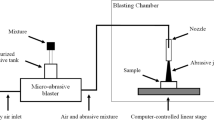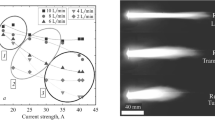Abstract
The response of solids (TOSP-1 polymethylmethacrylate, D1 aluminum alloy) to multiple collisions with 1-mm ice granules with an average velocity of about 100 m/s is experimentally studied at low climatic temperatures (–40°C). When ice granules collide with a target, 100-μm fragmentation particles are found to form and cause the destruction of the target surface.


Similar content being viewed by others
REFERENCES
G. G. Chernyi, “Mechanism of abnormally low resistance to motion of bodies in hard environments,” Dokl. Akad. Nauk SSSR 292 (6), 1324–1328 (1987).
V. I. Zel’dovich, I. V. Khomskaya, N. Yu. Frolova, S. M. Kheifets, S. M. Usherenko, and O. A. Dybov, “Structural changes in iron–nickel alloys caused by the action of a high-speed flux of powder particles. I. Shock-wave loading effects,” Fiz. Met. Metalloved. 91 (6), 72–79 (2001).
V. I. Zel’dovich, I. V. Khomskaya, N. Yu. Frolova, S. M. Kheifets, S. M. Usherenko, and O. A. Dybov, “Structural changes in iron–nickel alloys caused by the action of a high-speed flux of powder particles. II. Ultradeep penetration effects,” Fiz. Met. Metalloved. 94 (1), 90–98 (2002).
S. M. Usherenko, “Modern ideas about the ultradeep penetration effect,” Inzh.–Fiz. Zh. 75 (3), 183–198 (2002).
S. E. Aleksentseva and I. V. Zakharov, “Investigation of the energy processes during high-speed collision and ultradeep penetration of particles,” Naukosfera, No. 11-1, 136–141 (2020).
V. S. Trofimov, E. V. Petrov, and M. I. Alymov, “On the nature of superdeep penetration of shock-accelerated particles into a solid target,” Int. J. Self-Propagating High-Temp. Synth. 25 (2), 125–128 (2016).
C. Qi and J. Chen, “Physical mechanism of super-deep penetration of solid microparticles into solid targets,” J. Mech. Behav. Mater. 23, 21–26 (2014).
N. A. Zlatin, G. S. Pugachev, S. M. Mochalov, and A. M. Bragov, “Time dependence of the strength of a metal in a microsecond range,” Fiz. Tverd. Tela 17 (9), 2599–2602 (1975).
I. Langmuir, “Growth of particles in smoke and clouds and snow formation from supercooled clouds,” Usp. Fiz. Nauk XXXVII (3), 349–377 (1949).
Author information
Authors and Affiliations
Corresponding author
Ethics declarations
The authors declare that they have no conflicts of interest.
Additional information
To the cherished memory of Professor Aleksandr Vasil’evich Lyglaev, Doctor of Engineering, who made a great contribution to the theory of fracture mechanics
Translated by K. Shakhlevich
Rights and permissions
About this article
Cite this article
Syromyatnikova, A.S., Andreev, Y.M. & Zakharova, M.I. Experimental Study of the Destruction of Polymethylmethacrylate and an Aluminum Alloy by an Ice Granule Flux. Russ. Metall. 2022, 436–438 (2022). https://doi.org/10.1134/S0036029522040280
Received:
Revised:
Accepted:
Published:
Issue Date:
DOI: https://doi.org/10.1134/S0036029522040280




